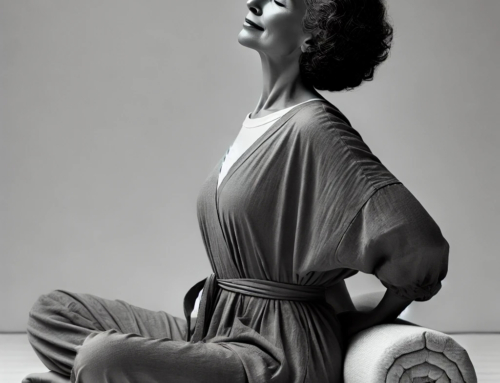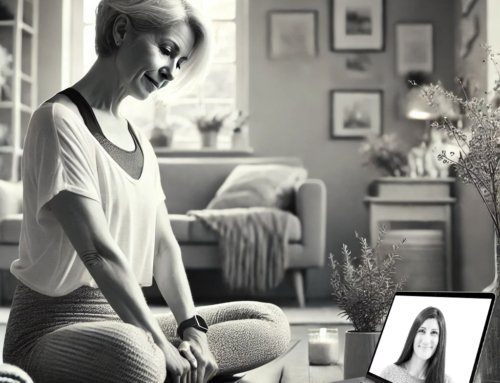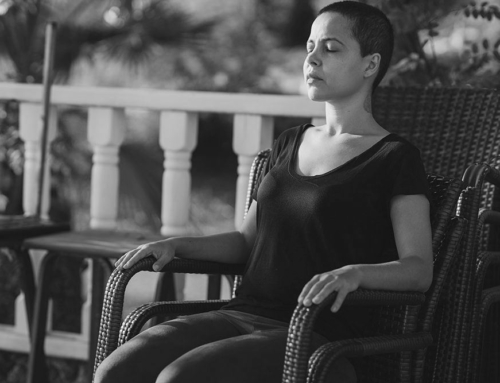This blog was originally published on Elephant Journal on 06.14.14, and has since been shared on Facebook over 22,000 times and has been read over 156,000 times. Read on for
Breathing is free. Breathing is what keeps us alive. The quality of our breath reflects the quality of our life.
Shallow, unconscious breaths kept me trapped in a tense, anxious cycle for years. Long, deep, conscious breaths bring me ease and stress relief.
It wasn’t until I started to become aware of breathing that I learned how to use it to heal. Doctors had me believe that I could find relief in a pill and for twelve, dark, tense years, I believed them.
Many of my clients with anxiety ask how I was able to get myself from point A to point B. Point A was a life with daily panic attacks and crippling anxiety so bad that I couldn’t leave the house. Point B is a life with reduced stress, an easy, positive attitude, and without anxiety altogether.
I make it very clear to my clients that the transition didn’t happen overnight and took incredible willingness to stare anxiety in the face. It was something that took practice, time, determination and hard work.
Sure, a pill will sedate you after the twenty or so minutes it takes to get into your blood stream. But does your anxiety really go away? Or, is it just masked by sleepiness? Looking back, I feel as though anti-anxiety meds rewarded me with a nap, never really bringing me relief.
This is what I did to overcome these intense emotions, and what I continue to do to manage normal nervousness before it spirals into full-blown anxiety:
Step one: acknowledge that the anxiety is there
Simply bring the light of awareness to your intense feeling. Shine that light so brightly on it that it has nowhere to run. Look at it. Locate it in the body, if you can. As difficult as it may be, try not to let the mind figure it out and think about it. Instead, feel it. Give it a color or shape. Acknowledge that as uncomfortable as it may be, it is in you.
Step two: allow it to be exactly as it is
After you acknowledge that anxiety is with you, allow it to be there fully. Surrender the desire to push it away. Ask yourself, “What happens if I feel this?” Become a witness and get curious about what it feels like. Allow anxiety to fill you up, even though you feel tremendously uncomfortable.
The best way out is through.
Step three: accept the situation with all its intensity
Bring to mind that anxiety is here because it needs to be. For some reason, you are currently using anxiety to cope. Your mind and body feel they need anxiety, for whatever the reason. Right now, because it is here, anxiety is serving you. Invite it in and allow it to be within you. If you are at the point where you find yourself desperately wanting to change it, it’s the perfect time to sit with it and accept it, so you can move through it.
Step four: breathe into it
Focus all of your attention on breathing, consciously becoming aware of what breathing feels like, rather than focusing on the thoughts running wild in your head. You are in control of not only your health, but what you focus on.
Notice if breaths are shallow (which will make you more anxious) or if your breaths are long and deep (which will bring you relief). Close your eyes and feel where the breath is in the body as every inhale and exhale flows. Feel free to bring your hands to your chest or belly to help guide the awareness there.
Longer and deeper breaths will signal the nervous system to calm down. These breaths will turn off “fight or flight”—which is what you are trapped in—and bring in relief.
Step five; keep yourself in the present moment
Often, anxiety comes on as the mind plays those “what-if” scenarios over and over, bringing in fear. At the core, we fear injury or death, for our loved ones or ourselves. Forget the why and just notice what is there for you in that moment. Ask yourself, “What is here for me now?”
Observe your environment through your senses and connect inward to body sensations. For example, feel your feet on the ground or hands resting on your legs. Feel your breath, feel the intensity. If the surrounding environment is creating more anxiety, ask yourself if you can change or accept the situation.
If you can change it, do so and if not, accept it.
Find a way to self-soothe; find comfort in discomfort. Making room for both will allow discomfort to begin to dissipate.
Step six: stick with it
Ignore the story that may be running in your head about how this isn’t working. Continue to slow down your breath and accept what is around you. Don’t believe everything you think and come back to feeling, no matter how much of a struggle it may feel like.
If your awareness wanders a hundred times, bring it back a hundred times.
Notice. Learn. Create a new habit. Grow stronger. Create lasting change.
Step seven: let go
Just as waves of the oceans ebb and flow, so must emotions during this human experience. Allow your anxiety to ebb and flow, to crest and recede, just like a wave. Release it after you feel it. Let it come in and flow back out.
Because anxiety has been serving you, it may be difficult to let it go. Notice if you have a tendency to cling to this emotion, and believe that it defines who you are. It’s not wrong or uncommon to feel this, especially if anxiety has been with you for a long time.
The simple truth is: anxiety, like all intense emotions, naturally comes and goes. Our ability to let it go and release it soothes our suffering and gives us the opportunity to settle into that lasting change and freedom we are so desperately seeking.
We find courage and strength with every exhale that we use to release anxiety and fear. It may not be easy, but it will be worth it. Often, letting go takes more courage than holding on.






Leave A Comment